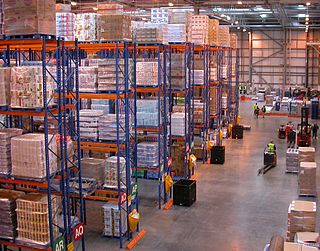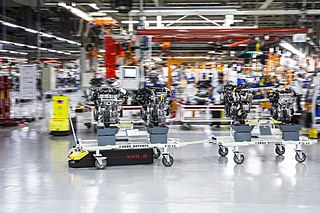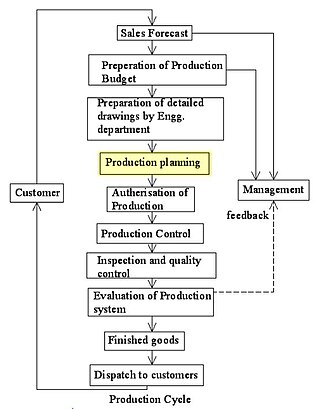Related Research Articles

Logistics is a part of supply chain management that deals with the efficient forward and reverse flow of goods, services, and related information from the point of origin to the point of consumption according to the needs of customers. Logistics management is a component that holds the supply chain together. The resources managed in logistics may include tangible goods such as materials, equipment, and supplies, as well as food and other consumable items.

Logistics automation is the application of computer software or automated machinery to improve the efficiency of logistics operations. Typically this refers to operations within a warehouse or distribution center, with broader tasks undertaken by supply chain engineering systems and enterprise resource planning systems.

A warehouse is a building for storing goods. Warehouses are used by manufacturers, importers, exporters, wholesalers, transport businesses, customs, etc. They are usually large plain buildings in industrial parks on the outskirts of cities, towns, or villages.

A performance indicator or key performance indicator (KPI) is a type of performance measurement. KPIs evaluate the success of an organization or of a particular activity in which it engages. KPIs provide a focus for strategic and operational improvement, create an analytical basis for decision making and help focus attention on what matters most.

A distribution center for a set of products is a warehouse or other specialized building, often with refrigeration or air conditioning, which is stocked with products (goods) to be redistributed to retailers, to wholesalers, or directly to consumers. A distribution center is a principal part, the order processing element, of the entire order fulfillment process. Distribution centers are usually thought of as being demand driven. A distribution center can also be called a warehouse, a DC, a fulfillment center, a cross-dock facility, a bulk break center, and a package handling center. The name by which the distribution center is known is commonly based on the purpose of the operation. For example, a "retail distribution center" normally distributes goods to retail stores, an "order fulfillment center" commonly distributes goods directly to consumers, and a cross-dock facility stores little or no product but distributes goods to other destinations.
A warehouse management system (WMS) is a set of policies and processes intended to organise the work of a warehouse or distribution centre, and ensure that such a facility can operate efficiently and meet its objectives.

An automated guided vehicle (AGV), different from an autonomous mobile robot (AMR), is a portable robot that follows along marked long lines or wires on the floor, or uses radio waves, vision cameras, magnets, or lasers for navigation. They are most often used in industrial applications to transport heavy materials around a large industrial building, such as a factory or warehouse. Application of the automatic guided vehicle broadened during the late 20th century.

An automated storage and retrieval system consists of a variety of computer-controlled systems for automatically placing and retrieving loads from defined storage locations. Automated storage and retrieval systems (AS/RS) are typically used in applications where:
Expense management refers to the systems deployed by a business to process, pay, and audit employee-initiated expenses. These costs include, but are not limited to, expenses incurred for travel and entertainment. Expense management includes the policies and procedures that govern such spending, as well as the technologies and services utilized to process and analyze the data associated with it.
A warehouse control system (WCS) is a software application that directs the real-time activities within warehouses and distribution centers (DC). As the “traffic cop” for the warehouse/distribution center, the WCS is responsible for keeping everything running smoothly, maximizing the efficiency of the material handling subsystems and often, the activities of the warehouse associates themselves. It provides a uniform interface to a broad range of material handling equipment such as AS/RS, carousels, conveyor systems, sorters, palletizers, etc. The primary functions of a WCS include:

Material handling involves short-distance movement within the confines of a building or between a building and a transportation vehicle. It uses a wide range of manual, semi-automated, and automated equipment and includes consideration of the protection, storage, and control of materials throughout their manufacturing, warehousing, distribution, consumption, and disposal. Material handling can be used to create time and place utility through the handling, storage, and control of waste, as distinct from manufacturing, which creates form utility by changing the shape, form, and makeup of material.
A Transportation Management System (TMS) is a subset of supply chain management concerning transportation operations, which may be part of an Enterprise Resource Planning (ERP) system.
Order processing is the process or work-flow associated with the picking, packing, and delivery of the packed items to a shipping carrier and is a key element of order fulfillment. Order processing operations or facilities are commonly called “distribution centers” or “DC 's”. There are wide variances in the level of automation associating to the “pick-pack-and-ship” process, ranging from completely manual and paper-driven to highly automated and completely mechanized; computer systems overseeing this process are generally referred to as Warehouse Management Systems or “WMS”.
Manufacturing execution systems (MES) are computerized systems used in manufacturing to track and document the transformation of raw materials to finished goods. MES provides information that helps manufacturing decision-makers understand how current conditions on the plant floor can be optimized to improve production output. MES works as real-time monitoring system to enable the control of multiple elements of the production process.
Voice-directed warehousing (VDW) refers to the use of the voice direction and speech recognition software in warehouses and distribution centers. VDW has been in use since the late 1990s, with its use increasing drastically since.
Distribution Center Management System (DCMS) is a user friendly Warehouse Management System (WMS), designed to track the activities performed in a distribution center (DC)/warehouse. It is created and owned by a private company called Eclipse Systems Pvt Ltd. It automates the entire process flow of receiving, managing and shipping goods to customers from the warehouse. DCMS solutions are designed for both large and small scale businesses. In January 2015, the product went open source.

Production planning is the planning of production and manufacturing modules in a company or industry. It utilizes the resource allocation of activities of employees, materials and production capacity, in order to serve different customers.
Warehouse execution systems (WES) are computerized systems used in warehouses and distribution centers to manage and orchestrate the physical flow of products from receiving through shipping. Warehouses are storage facilities for raw materials and parts used in manufacturing operations; distribution centers (DCs) are facilities that store and distribute finished goods to retail locations, consumers, and other end customers.
Omnichannel order fulfillment is a material handling fulfillment strategy and process that treats inventory as fully available to all channels from one location. While the internal fulfillment process may diverge to optimize the operations, the outbound process only diverges at the point of pack out and shipping.
A transportation and warehouse management system (TWMS) is a software application that supports eCommerce, distribution, and third-party logistics (3PL) companies within supply chain management.
References
- ↑ Dan Gilmore, "Warehouse Management: To Wave or not to Wave?", Supply Chain Digest, June 8, 2006. Accessed 12 June 2014
- ↑ Oracle Warehouse Management User's Guide, v12.1. Accessed 12 June 2014
- ↑ "Key Considerations for Effective E-Commerce Fulfilment - SIPMM Publications". publication.sipmm.edu.sg. 2020-02-17. Retrieved 2022-12-18.